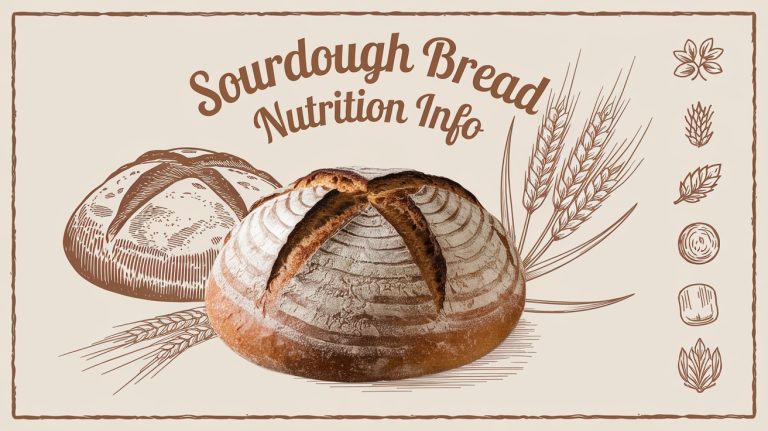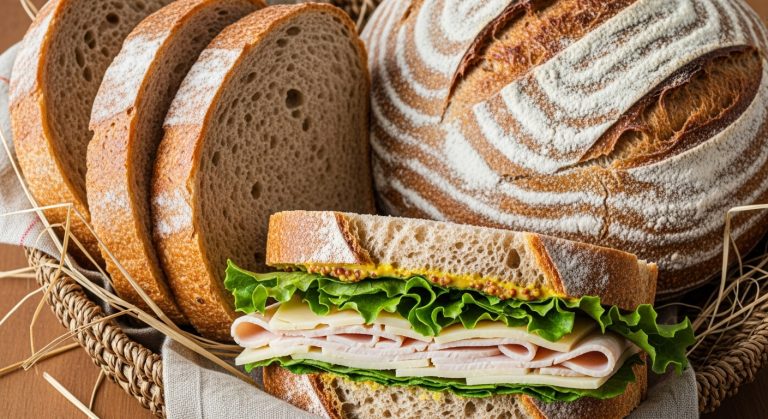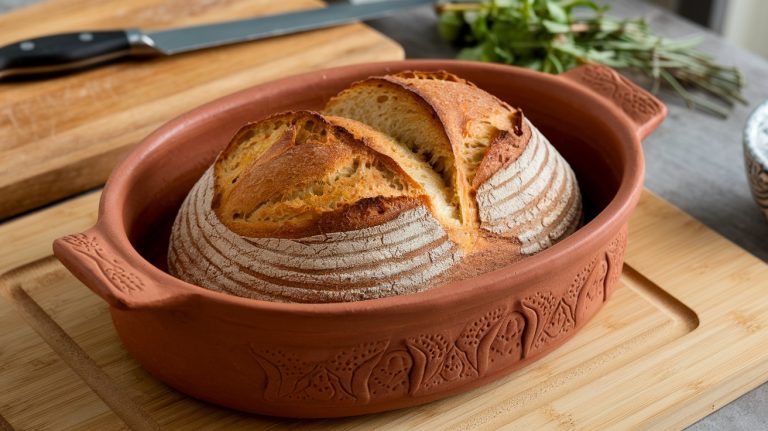Blueberry Cream Cheese Sourdough Bread: Warm, Creamy and Fruity
You’re in for a treat with Blueberry Cream Cheese Sourdough Bread! This delicious loaf marries the tangy flavor of sourdough with creamy, sweet cream cheese and bursting blueberries.
Start with a blend of bread flour and spelt or rye for depth. Mix in a fluffy cream cheese filling sweetened with sugar and a splash of vanilla.
Once your dough has been proofed and fermented perfectly, bake it in a preheated Dutch oven for a golden crust. The irresistible combination of flavors creates indulgent bites. Want to elevate your baking game even further? There’s plenty more to explore.
Key Takeaways
- Combine 250g fresh blueberries with 8 oz softened cream cheese, sweetened with sugar and vanilla, to create a flavorful filling.
- Use a mix of 210g bread flour, 45g spelt, and 45g rye for a robust dough texture or opt for 440g all-purpose flour.
- Incorporate a 60g levain or 100g active sourdough starter, 207g water, and 6g salt for optimal fermentation and flavor development.
- Bake the shaped dough in a preheated Dutch oven at 450°F, covering for the first 25 minutes to achieve a crispy crust.
- Cool baked bread on a wire rack for at least one hour before serving to prevent sogginess and maintain freshness.
Key Ingredients Overview
When crafting your Blueberry Cream Cheese Sourdough Bread, understanding the key ingredients is essential for achieving that perfect balance of flavors and textures.
Start with your flour choice; you can combine 210g of bread flour with 45g each of spelt and rye, or simply use 440g of all-purpose flour for a more straightforward approach. Bread flour’s higher protein content contributes to a better gluten structure, which is crucial for the bread’s rise.
Water plays an important role too—using 207g plus 15g for the salt, or 260g if you prefer a single measurement.
Don’t forget the levain or starter, which gives your bread that signature sourdough flavor. You’ll need 60g of 100% hydration levain or 100g of an active sourdough starter. Direct addition of fresh blueberries can increase dough moisture, so it’s advisable to mash them to extract pulp without excess moisture.
A little salt, about 6g, enhances the overall taste, while optional ingredients like lemon zest, maple syrup, or vanilla extract can elevate your bread further.
For the delightful blueberry and cream cheese filling, make sure you have 250g of fresh blueberries and at least 8 oz of cream cheese.
Toss the blueberries in flour to keep them from sinking and fold them in during shaping.
Preparing the Cream Cheese Filling
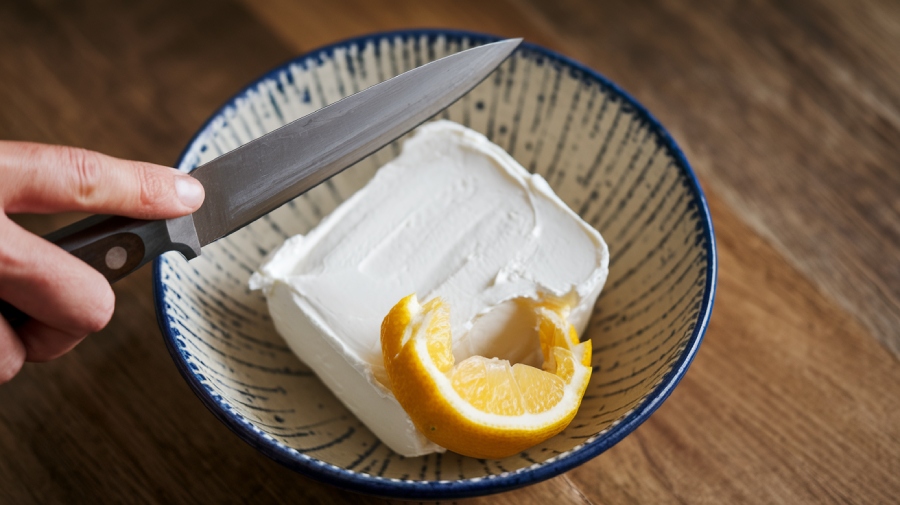
To create a luscious cream cheese filling for your Blueberry Cream Cheese Sourdough Bread, start with 8 oz (225g) of block cream cheese, which provides a rich and creamy consistency. Before mixing, soften the cream cheese for easier blending.
In a mixing bowl, combine the softened cream cheese with sugar until well incorporated; this sweetens the filling beautifully. For an extra layer of flavor, add a splash of vanilla extract, stirring it in until the mixture is smooth.
You can use an electric mixer for a quick blend or opt for hand mixing if you prefer more control over the texture. Just make sure that the filling reaches a creamy consistency, as this will enhance the overall experience of your bread. The sourdough fermentation process improves digestibility, making this filling not only delicious but also healthier.
Don’t hesitate to adjust the amount of cream cheese based on your taste preferences—more cream cheese yields a richer filling!
For convenience, you can prepare this filling ahead of time and refrigerate it. Using chilled filling helps maintain its shape during baking, making certain it integrates perfectly with the blueberries for that delightful balance of flavors.
Dough Mixing Techniques
Dough mixing techniques play an essential role in crafting the perfect Blueberry Cream Cheese Sourdough Bread. By mastering these methods, you guarantee a well-developed dough that’s ready for the delicious fillings to come. Here’s what you need to focus on:
- Start with Water: Always add water first to maintain accurate measurements.
- Porridge-like Consistency: Create a base by mixing half the flour with water and starter for easier blending.
- Rest is Key: Allow the dough to rest after initial mixing for better hydration. This rest period can enhance the dough’s hydrogel formation, improving its elasticity and overall texture.
Begin by mixing the sourdough starter with water, breaking it down for a cloudy mixture.
Blend your flours separately to achieve even distribution. When you combine your ingredients, do so gradually, making sure you don’t overmix. This is vital for a tender crumb.
After the autolyse phase, add salt, as it can inhibit gluten development if added too early. Throughout this process, keep an eye on making sure all ingredients, like sticky sweeteners, are evenly distributed.
Kneading the Sourdough
Kneading the sourdough is where the magic truly begins, transforming your mixed ingredients into a cohesive, elastic dough. You’ll want to choose a technique that suits your dough’s hydration level. The two primary methods are the bench kneading and slap and fold techniques.
| Technique | Description | Ideal For |
|---|---|---|
| Bench Kneading | Push and stretch dough using your palm. | Drier doughs |
| Slap and Fold | Slap dough onto the counter and fold it over. | Wetter doughs (78%+ hydration) |
| General Kneading | Move, turn, and repeat for even gluten development. | All dough types |
If you opt for bench kneading, place your dough on a flat surface and push it with the heel of your palm for about 10 to 15 minutes. If you’re working with wetter dough, the slap-and-fold method will keep things manageable.
Remember to test for elasticity and let your dough rest afterward to relax the gluten. As you knead, use a dough scraper to keep things tidy and avoid over-kneading, ensuring your sourdough is just right for the next step!
Developing gluten structure through kneading is essential for enhancing dough elasticity and improving texture. Additionally, proper hydration levels around 66% hydration can significantly impact gluten formation during the kneading process.
Proofing and Fermentation Process
The proofing and fermentation process is essential for developing the unique flavor and texture of your blueberry cream cheese sourdough bread.
During bulk fermentation, you’ll notice the dough transforming as it rises and develops a network of gas bubbles, thanks to your sourdough starter. Proper proofing knowledge allows you to adjust fermentation times based on environmental factors, ensuring that your dough reaches its full potential. Maintaining optimal dough temperature is key to achieving a successful rise and flavor development.
Using techniques like the stretch and fold method helps strengthen the dough while ensuring those delightful inclusions stay intact for a deliciously tangy loaf.
Importance of Bulk Fermentation
In the heart of sourdough bread making lies the essential step of bulk fermentation, where the dough comes together as a cohesive mass to develop its unique flavor and structure. This stage is vital, typically lasting 4-5 hours at room temperature, allowing the yeasts and bacteria to work their magic.
Additionally, this process is crucial for developing flavors and ensuring the dough’s strength. The dough should be monitored closely, as stretch and fold techniques can be employed during this stage to further enhance its structure.
- Enhances flavor and texture
- Guarantees a well-risen, strong dough
- Prevents issues like over or under-fermentation
During bulk fermentation, you’ll notice the dough increasing in volume, ideally by 30-75%. Keep an eye on its bubble activity—this is a sign that fermentation is progressing. If you skip or rush this step, you risk compromising your bread’s quality; it could turn dense or gummy.
Temperature control is key; warmer conditions speed up fermentation while cooler ones slow it down, allowing for flexibility in your baking schedule. Monitoring the dough’s hydration level is also important, as it can significantly affect the final texture of your sourdough.
Stretch and Fold Technique
To elevate your sourdough game, mastering the stretch and fold technique is essential. This method strengthens your dough without kneading by activating the gluten, leading to a lofty rise and an open crumb structure. It also gently incorporates air, ensuring even fermentation and preventing temperature discrepancies. Additionally, the stretch and fold technique is effective for improving dough strength and volume, making it suitable for various hydration levels.
Begin by wetting your hands to avoid stickiness. Stretch the dough upward from the sides, folding it toward the center. Rotate the bowl by a quarter turn after each stretch. Completing one set involves four stretches and folds around the bowl, followed by a rest period of 15-30 minutes.
You’ll want to perform 3-5 sets during the bulk fermentation phase to transform your dough from weak and shaggy to strong and elastic. Optimal results can be achieved by completing a total of five sets for best dough development.
Adjust your technique based on the dough’s strength—use a more vigorous method for slack dough and a gentler approach for stronger dough. Keep a close eye on how your dough responds, as this will guide your adjustments.
Proofing Dough Correctly
Proofing dough correctly is an essential step in achieving that perfect blueberry cream cheese sourdough loaf. This process allows the dough to rise and develop flavor, ensuring a light and airy texture. Here’s what to keep in mind:
- Temperature Control: Warm temperatures speed up proofing, while cold temperatures enhance flavor. A well-stored starter can contribute to consistent baking.
- Visual Cues: Look for a pillowy dough that’s doubled in size and shows air bubbles.
- Poke Test: This simple test helps you gauge readiness—if it springs back slowly, it’s time to shape.
You can opt for a quick warm proof lasting 1-2 hours, or a cold proof overnight in the fridge to deepen flavor. Inclusions like blueberries and cream cheese can also influence the proofing process, as they add moisture and require careful handling.
During the final proof, place your shaped dough in a banneton, cover it, and let it rest. The dough should look airy and wobble slightly when shaken.
Baking Instructions and Tips
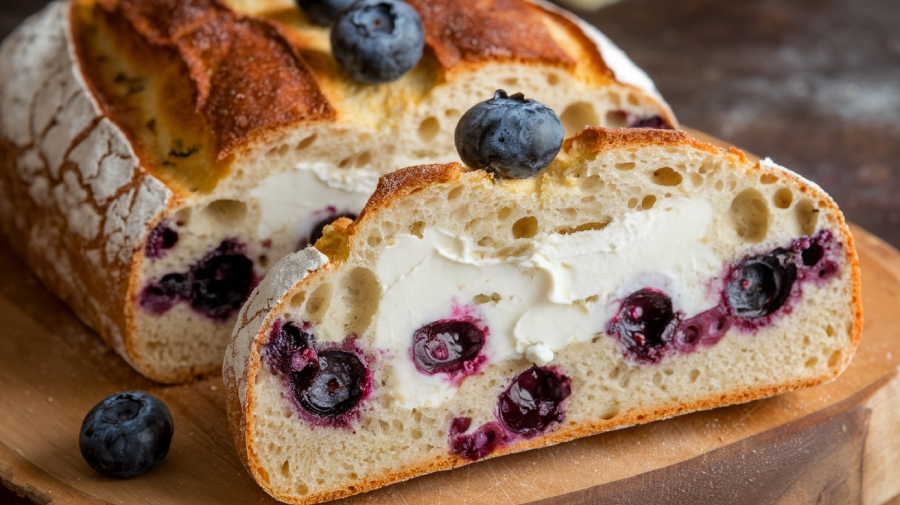
Baking a delicious blueberry cream cheese sourdough bread is an exciting journey that combines art and science. Start by preheating your oven to 450°F (232°C) and placing your Dutch oven with the lid inside to heat up.
Before you bake, chill your dough in the refrigerator for 12 hours. This step enhances flavor and texture. Just before scoring, freeze the dough for 10 minutes to firm it up. Remember, allowing the dough to rise until it doubles in size contributes to the gluten structure and overall texture of the bread.
When you’re ready to shape, gently fold the dough over the blueberries and cream cheese to keep them snugly inside. Shape it into a round loaf, ensuring all ingredients are incorporated to prevent any from escaping during baking. Additionally, using a heavy cast iron Dutch oven creates a humid baking environment that results in a crusty exterior.
For scoring, use a lame, razor blade, or sharp knife for clean cuts. Bake your bread in the preheated Dutch oven with the lid on for 25 minutes to create steam, then remove the lid and bake for an additional 20 minutes until it’s dark golden brown.
Keep an eye on the temperature and color for the best results. Remember, an active sourdough starter is key, and avoid overmixing to maintain that delicate sourdough structure. Enjoy the process!
Cooling and Serving Suggestions
Once your blueberry cream cheese sourdough bread has emerged from the oven, the next essential step is cooling it properly to guarantee the perfect texture and flavor.
Start by removing the Dutch oven and placing the bread on a wire cooling rack. Allow it to cool for at least one hour, or until completely cooled off. This cooling process prevents the inside from becoming soggy and helps you achieve cleaner slices. Additionally, it is advisable to store the bread in an airtight container after cooling to maintain its freshness. The fermentation process enhances the flavor, making the bread even more enjoyable.
When it comes to serving, there are delightful ways to enjoy your creation:
- Spread a generous layer of cream cheese for a rich topping.
- Drizzle some honey or slather on a bit of butter for added sweetness.
- Enjoy it plain for a truly rustic experience.
Variations and Customizations
Explore the endless possibilities of variations and customizations that can elevate your blueberry cream cheese sourdough bread to new heights. With a few simple tweaks, you can create a unique flavor profile that suits your taste.
- Fruit Combinations: Mix blueberries with raspberries for a delightful tartness.
- Cream Cheese Twists: Try using honeyed cream cheese for a sweet surprise.
- Spice It Up: Add a hint of cinnamon for warmth and depth. Bialy serves as a versatile base for both sweet and savory variations, inspiring new ideas for your recipe.
You can also play around with your sourdough and leavening options. If you prefer a tangy flavor, stick with a sourdough starter.
Alternatively, adding yeast will give you a lighter texture and a quicker rise.
Don’t forget about toppings! A sprinkle of cinnamon sugar before baking adds a sweet crunch, while fresh blueberries on top can enhance moisture and flavor.
Storage and Freshness Tips
To keep your blueberry cream cheese sourdough bread fresh, store it in a cool, dry place and cover it properly to lock in moisture. If you’ve got leftovers, reheating them in the oven will bring back that delightful crispy crust. Sourdough freezes well, so if you want to keep your bread for a longer period, consider storing it in freezer-safe bags to maintain its freshness. Let’s explore the best ways to guarantee your delicious bread stays as tasty as the day you baked it!
Ideal Storage Conditions
When it comes to keeping your blueberry cream cheese sourdough bread fresh, the right storage methods can make all the difference. Proper storage not only preserves its delightful flavor and texture but also extends its life. Here are some essential tips to maximize freshness:
- Store your bread cut-side down to prevent drying out.
- Keep it in a cool, dry place away from direct sunlight.
- Avoid the refrigerator; it can zap the moisture.
Let your bread cool completely before slicing, as this helps maintain that perfect crust. Use a breadbox for a consistent environment, and if you’re in a humid area, opt for an airtight container to prevent mold. Additionally, maintaining the right environmental conditions is crucial since humidity and dryness significantly impact bread preservation.
Ideally, keep your bread at room temperature, between 60-70°F (15-21°C).
For longer storage, you can freeze your loaf after cooling, wrapping it tightly in plastic wrap before placing it in a bread bag. This way, you can enjoy your homemade treat for up to 1-2 months!
Frequently Asked Questions
Can I Substitute Other Fruits for Blueberries?
Absolutely, you can substitute other fruits for blueberries!
Blackberries and raspberries work perfectly using a 1:1 ratio, while strawberries should be chopped to match the texture.
Currants deliver a more intense flavor, so consider using slightly less.
Mulberries can add a sweet-tart twist as well.
Just remember to adjust sugar levels and handle the fruits gently to keep them intact.
Enjoy experimenting with these flavorful alternatives in your baking!
How Do I Know When My Sourdough Starter Is Ready?
To know when your sourdough starter’s ready, look for a few key signs.
It should double in volume within 4-6 hours after feeding, with plenty of bubbles on the surface.
Perform the float test—if it floats in water, it’s light and airy.
You’ll also notice a pleasant, yeasty smell.
Aim for a thick, stretchy texture similar to warm peanut butter, ensuring it’s primed for baking delicious bread.
Patience is key!
What Texture Should the Dough Be After Kneading?
Your dough should feel like a silky dream after kneading! Aim for a smooth, satiny texture that pulls away from the bowl, forming a perfect ball.
You’ll know it’s ready when it stretches thin without breaking during the windowpane test.
Don’t forget, over-kneading can turn it sticky, so keep an eye on that elasticity.
If you’re using a stand mixer, just 4-6 minutes can work wonders! Happy kneading!
Can I Use a Different Type of Cheese?
Absolutely, you can use different types of cheese in your sourdough!
Experiment with cheddar for a sharp kick, or mozzarella for a milder taste. If you’re feeling adventurous, try feta or gouda for unique flavors.
Just remember, shredding cheese yourself helps avoid those anti-caking agents in pre-packaged varieties.
Pay attention to how the cheese melts and integrates into the dough, as this can really elevate your bread’s overall flavor and texture!
How Can I Tell if the Bread Is Fully Baked?
Imagine pulling a loaf from the oven, its golden crust crackling like autumn leaves.
To tell if your bread’s fully baked, check the internal temperature; aim for 205-210°F.
Tap the bottom; it should sound hollow, and the loaf should feel light in your hands.
A toothpick test can also confirm doneness—if it comes out clean, you’re golden!
Trust your instincts and enjoy the delightful aroma as it cools.
Create Memories, One Slice at a Time
In the end, your blueberry cream cheese sourdough bread is bound to impress, just like a 1950s diner’s jukebox spinning your favorite tunes. As you slice into that golden crust and reveal the creamy, fruity filling, you’ll savor every bite.
Share it warm with friends or enjoy it solo; either way, you’ve created a delightful treat that’s sure to become a staple in your kitchen. So, don’t hesitate—bake it again and again.





